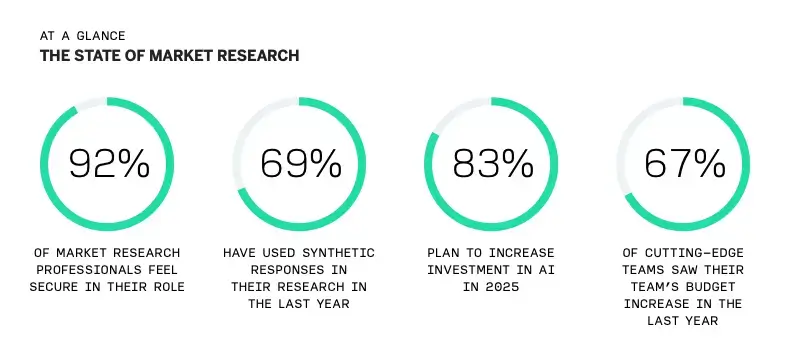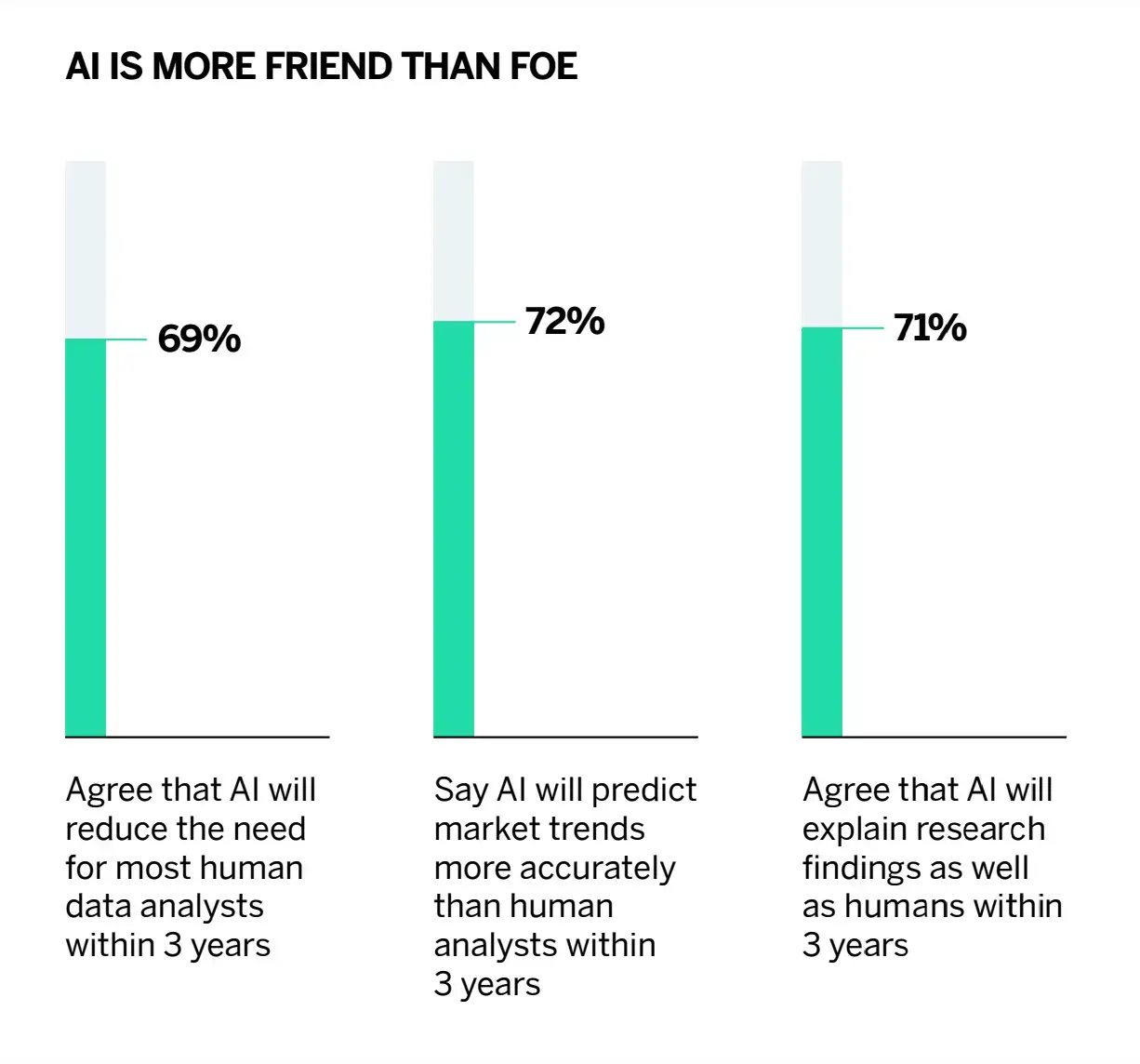
Brand Experience
The 4 market research trends redefining insights in 2025
If there’s one thing every researcher globally can agree on it’s this: The use of Artificial Intelligence in market research is not a passing fad; it’s a fundamental shift here to stay.
AI is permeating all corners of market research, supercharging efforts and enhancing results at a scale never seen before. The market researchers, teams, and businesses fully embracing its capabilities are more able to predict trends with greater accuracy, improve team efficiency, refine strategies for designing captivating UX, and so much more.
Research teams may be better equipped than ever to deliver more impactful insights at increased speeds, but technological change is also redefining consumer behavior. From customer feedback to interactions on social media platforms, we’re also witnessing a fundamental shift in how people interact and engage with brands – shaping how effective research can be.
Based on insights from over 3,000 researchers from across the globe, the 2025 Qualtrics Market Research Trends report reveals how AI is elevating research teams' work and outlines actions your organization can take to be at the forefront of what’s next.
Read on to see the four key industry trends from our latest study.
What’s the current state of market research?
The current landscape of market research is inevitably defined by the rapid technological advancements taking place within it, with AI taking center stage.
As businesses face increasing pressure to deliver faster, more impactful insights, AI-powered tools are being adopted at an unprecedented pace. Research teams are no longer just data providers – they're becoming strategic partners, using advanced technology to predict market trends, analyze consumer behavior, streamline operations, and make more informed decisions.

This shift is reshaping how research is conducted. Traditional methods are being augmented by digital tools that allow for cost-effective feedback at scale, improved accuracy through synthetic data and increased sample diversity. Qualitative research is also evolving, with digital platforms making it easier to gather deeper human insights remotely.
The result? Research teams are not only delivering better results and a deeper understanding – they’re also gaining more influence within their organizations. They're securing bigger budgets, greater freedom and a stronger voice at the executive level – putting them in a prime position to help shape the direction of their organizations.
As we head into 2025, this transformation will only accelerate, driven by the continued integration of AI and ever-growing demand for data-driven decisions in this age of intelligence.
What are the top market research trends for 2025?
Teams that innovate have more influence and larger budgets
In today’s rapidly changing market, research teams that embrace a culture of innovation are gaining significant influence and resources. With consumer preferences evolving faster than ever and the needs of businesses outpacing the results from traditional research, leading teams are adopting AI, machine learning and automation to deliver quicker, more impactful insights to stay competitive.
The demand for research is growing, with 66% of today’s cutting-edge research teams reporting increased requests in the past year. Research teams are no longer just supporting stakeholders – they’re becoming key strategic partners. 71% of cutting-edge teams report that their organization now relies more heavily on their insights than a year ago, giving them greater visibility and influence at the executive level.
These teams more often than not find themselves with larger budgets and more freedom to experiment with new research methods, positioning researchers at the forefront of innovation and business strategy.
Synthetic data is turning privacy by design into competitive advantage
The growing use of synthetic data is a market research trend that’s set to transform how research is conducted – offering a solution to privacy concerns, data scarcity, survey fatigue and more.
These artificial responses mimic real-world information, allowing researchers to gather insights without putting sensitive data from their target audience at risk. As a result, companies can protect intellectual property while still gaining valuable insights.
Synthetic data allows for quicker, cost-effective research, providing limitless capacity for responses and, in doing so, opens the door for researchers to explore topics more broadly. For research teams with limited budgets, synthetic data offers a fast, cost-efficient way to deliver high-quality insights, identify emerging trends and make data-driven decisions with confidence while potentially reaching more diverse populations
In 2025, adoption of synthetic data will be one of the most transformative innovations to market research as we shift our decision making away from human only audiences to synthetic + human feedback. Besides speed and efficiency, synthetic will let researchers test concepts in minutes and predict behavioral outcomes - all while maintaining privacy.
- Ali Henriques, Global Head of Research Services
The promise of synthetic data is now being reflected in the speed of its update: despite initial hesitation, 87% of researchers who have used synthetic responses report satisfaction with the results. And with 71% of respondents agreeing that synthetic data will account for over half of data collection within three years, there’s plenty more to come.
AI will be a permanent member of the modern research team
The days of research teams being overwhelmed with tedious tasks like data cleansing, summarization and reporting are a thing of the past. AI is becoming your research team’s go-to assistant, automating routine processes and allowing researchers to focus on more meaningful work – the foundational promise of AI in action.

Already, 89% of researchers are using AI-powered tools regularly or experimenting with them. These tools bridge the gap between traditional methods and modern research, streamlining operations and making it easier to reach valuable data and insights. From conversational analytics to automatic reporting, AI-driven innovations are transforming how research is conducted, improving efficiency and deepening insights.
However, as AI becomes more sophisticated, concerns around the reliability of AI-generated responses are growing: nearly half of researchers (49%) identify the challenge of distinguishing between real and AI-generated responses in online panels. Despite these concerns, researchers are confident that AI will continue to enhance their efforts.
With 83% of researchers planning to substantially increase investment in AI, it's clear that it will play a permanent role in shaping modern research.
Digital qual tools make it simple to keep the human element
The pandemic was the catalyst that pushed researchers online. But while COVID-19 restrictions have faded into memory for most, the shift to digital isn’t slowing down.
With demand for research at an all-time high, teams are turning to digital tools that enhance qualitative research without the need for additional budgets or resources. Face-to-face methods, however, still have their place – the goal now is to combine the best of both worlds.
AI is playing a critical role in this transformation, driving innovation in areas like focus groups, eye tracking, video analysis, and usability testing. These advancements allow researchers to reach more participants, gather real-time data and improve cost-effectiveness – all while keeping the personal touch that qualitative research demands.
There’s a clear correlation between AI use and increased demand for qualitative research, with 74% of AI-using researchers seeing a rise in demand. Flexibility, AI advancements and the challenges of quantitative research are fueling this trend.
Striking the right balance between digital and human-focused methods is key to pushing market research forward, ensuring that as AI becomes more integral, the human element remains at the heart of qualitative insights.
What matters most to researchers in 2025?
As we look toward 2025, while tools and technologies are rapidly changing, the core priorities of market researchers remain steadfast: building more efficient teams, uncovering market trends, collecting insights to drive strategy and product design, and using these insights to maximize marketing efforts.
But with these advancements come new expectations and challenges.
The 2025 Qualtrics Market Research Trends report reveals that, more than ever, there is a growing demand for extensive research to shape marketing strategies, improve customer satisfaction and drive business decisions. As technology advances, the challenge is balancing innovation with the human element, influencing how research teams operate and contribute to strategy.
In 2025, mastering these priorities will be essential for researchers to navigate an industry that continues to evolve at an unprecedented pace.
Accuracy and actionable insights
With AI and advanced analytics now central to the research process, accurate, data-driven insights are more accessible than ever – and therefore more critical than ever.
Researchers are focused on providing not just more data, but data that can be immediately applied to shape business strategies, customer experiences and product development. Teams that can deliver clear, actionable insights will continue to rise in influence.
Speed and efficiency
The pressure to deliver insights faster – without sacrificing quality – is at an all-time high. Today’s innovative researchers are increasingly relying on AI, automation, and synthetic data to meet tight deadlines while maintaining the same rigorous standards.
As demand for research grows, especially in fast-paced industries, speed will be key to staying competitive.
Balancing innovation with human connection
While digital tools and AI are reshaping how research is done, maintaining the human element is still crucial.
Researchers are on the hunt for a balance between cutting-edge tools and methods that allow them to capture authentic, human insights from their target market. Whether through augmented qualitative research or hybrid approaches, the focus is on blending technology with empathy.
How research and technology impact business decisions and planning
The latest research tools and AI technologies are empowering researchers to deliver deeper, more actionable insights.
AI, in particular, is playing a transformative role, automating repetitive tasks and providing a depth of analysis to complement any human’s. By integrating AI into the research process, teams can and are accessing a wealth of data faster, streamlining reporting and focusing on higher-value strategic tasks.
AI-driven innovations, like Qualtrics® conversational surveys and automated workflows, are enabling organizations to personalize feedback collection and turn complex data into clear, actionable insights. These tools help researchers not only understand customer behavior but also predict future needs and address areas of friction in real time. Where researchers are leveraging AI to simulate market scenarios, businesses are better equipped to plan effectively, make data-driven decisions with confidence and build a competitive edge.
As we look to the future, AI will continue to enhance the way organizations connect with customers and improve decision-making.
The 2025 Qualtrics Market Research Trends report delves deeper into how these tools are reshaping the landscape. Analyzing the input of thousands of researchers, our latest edition outlines future trends and offers practical guidance on how your organization can harness these innovations to stay ahead in an increasingly competitive market.
Dive deeper into the 2025 market research trends